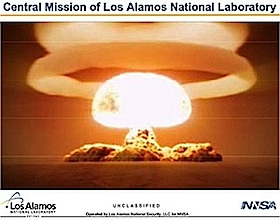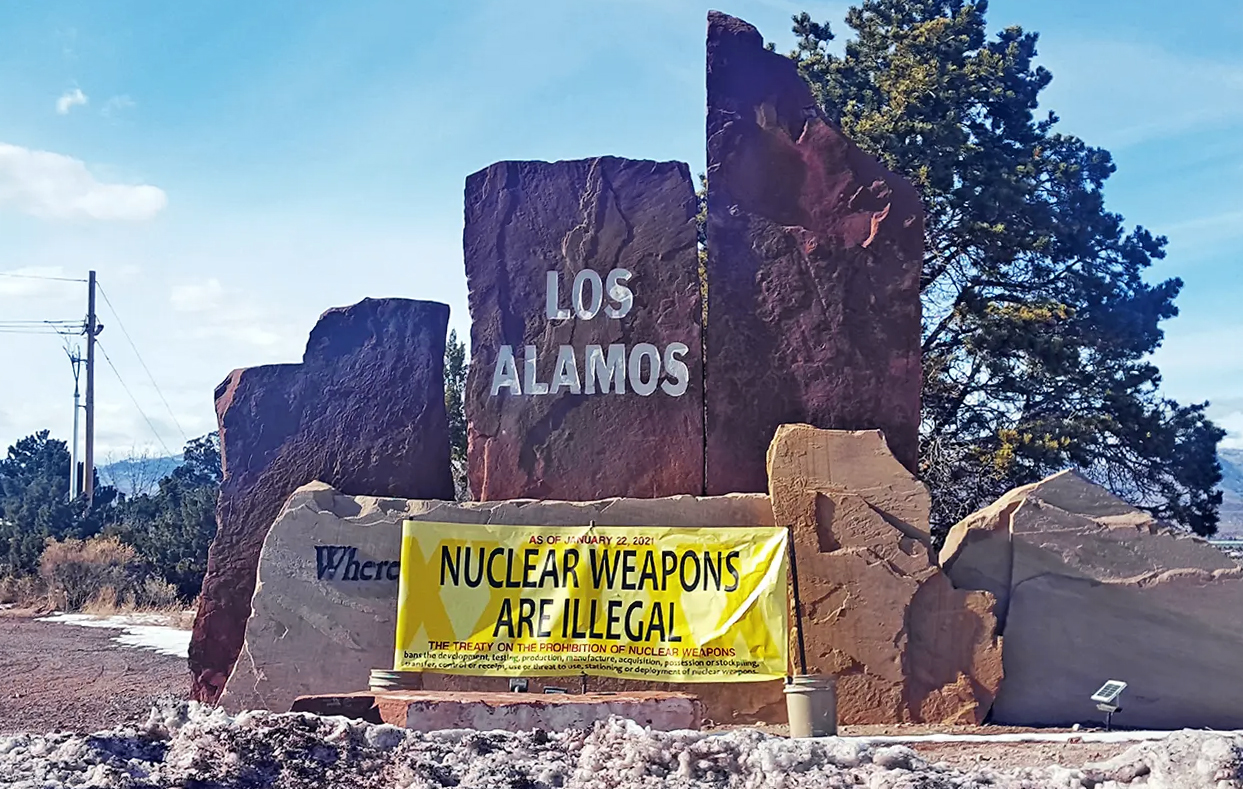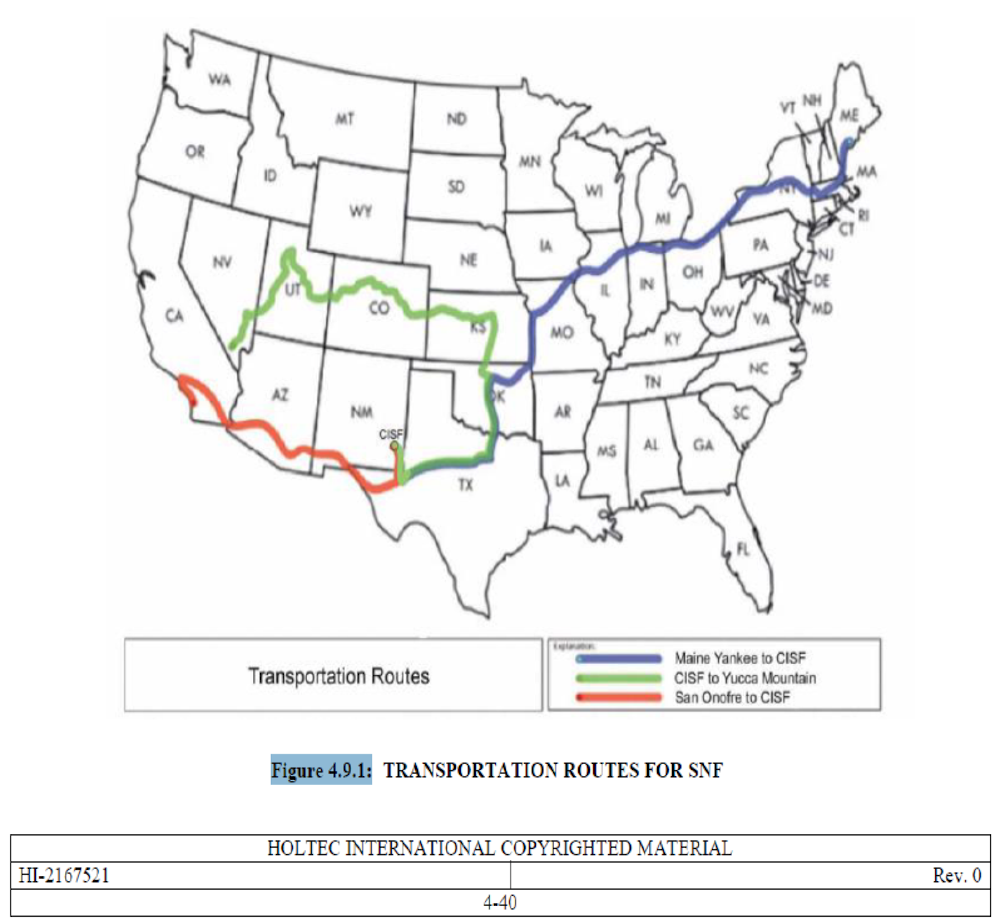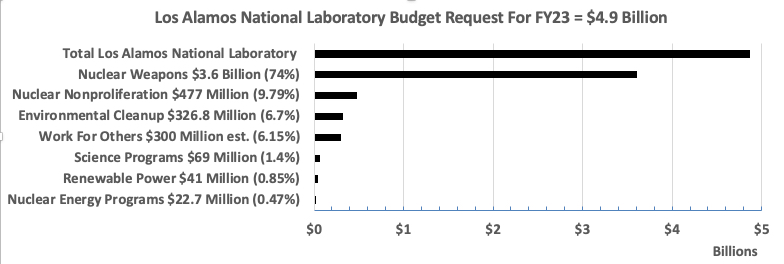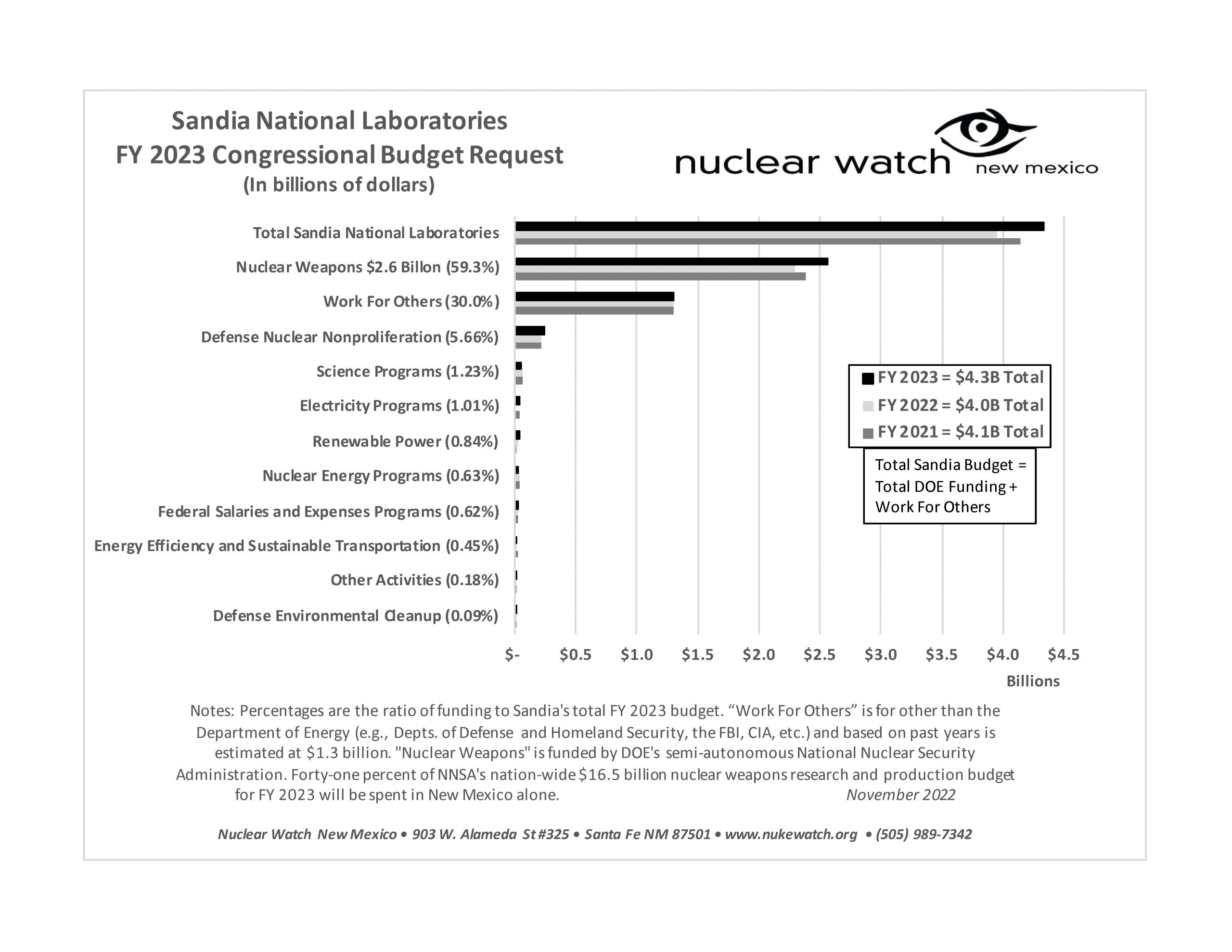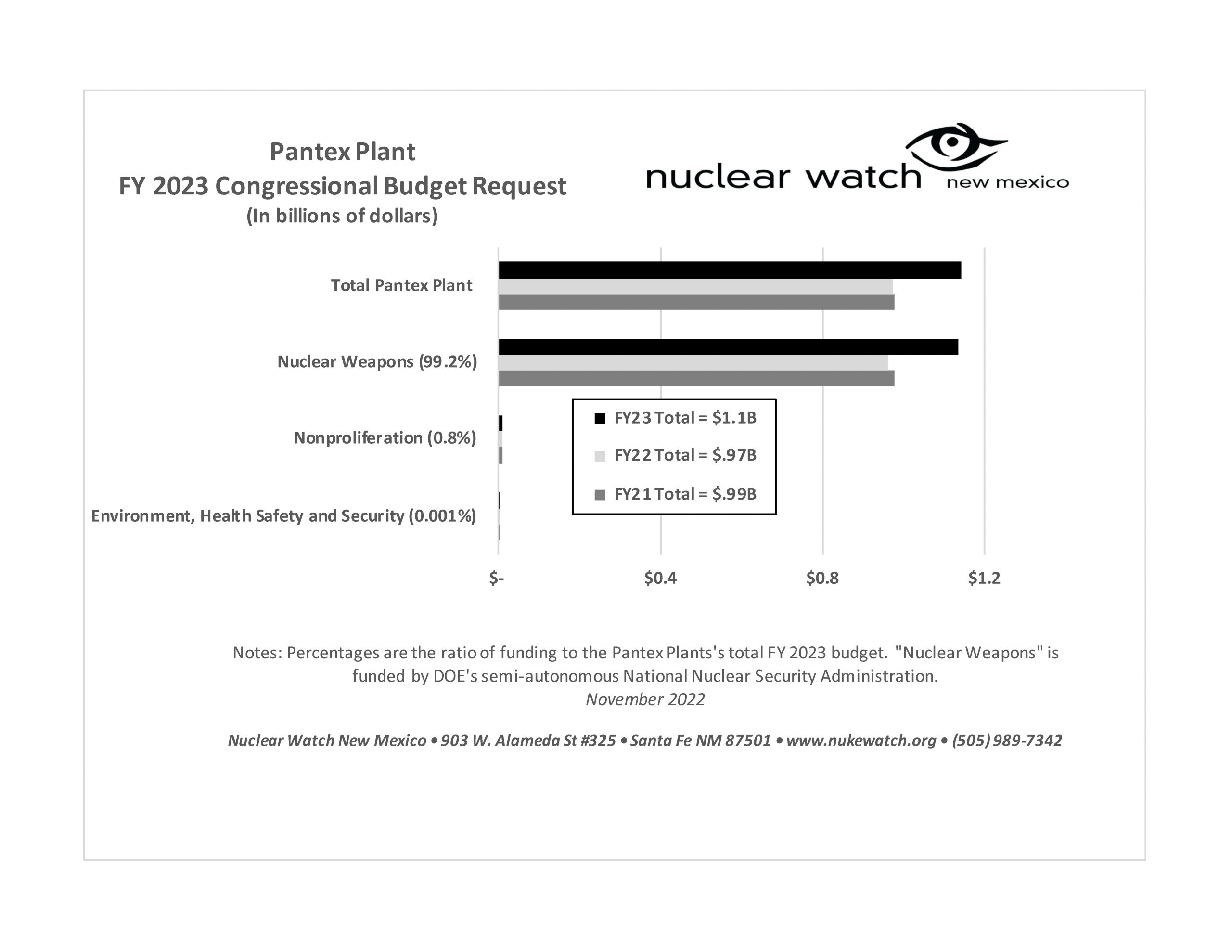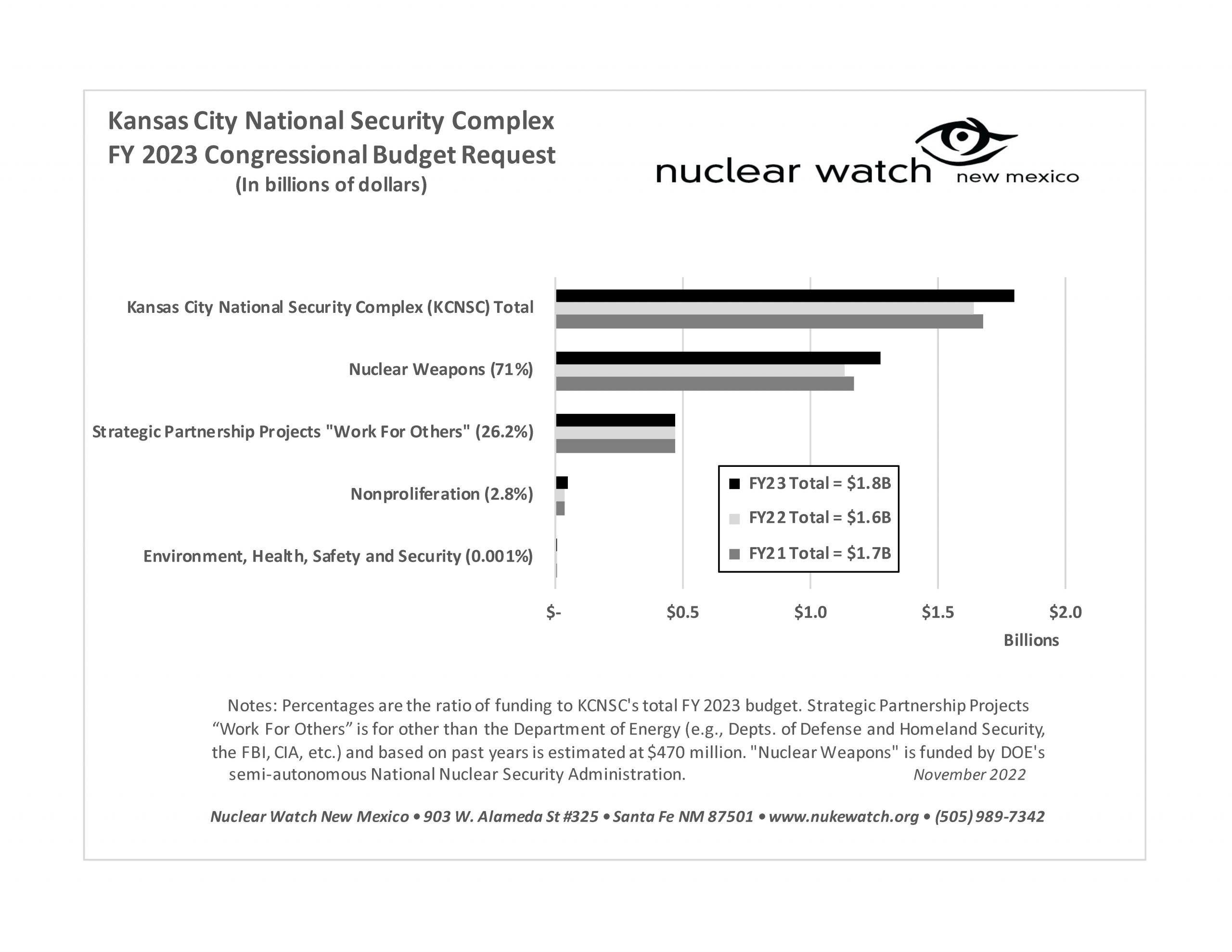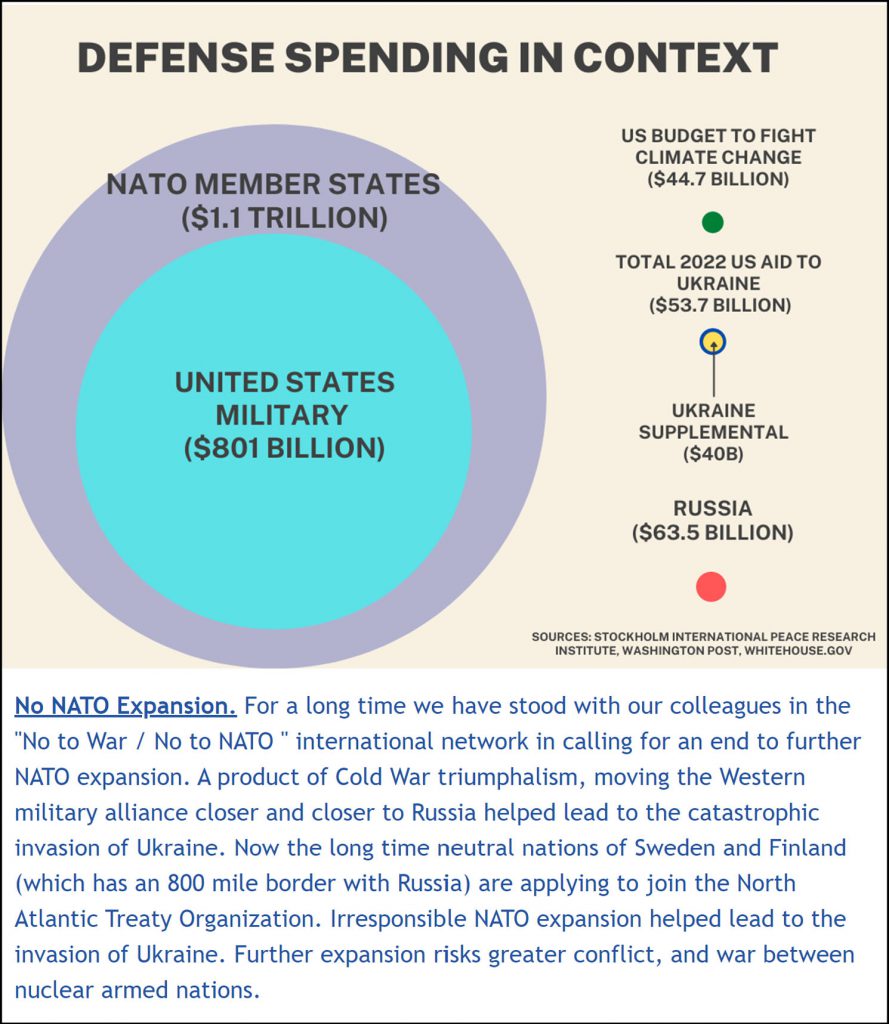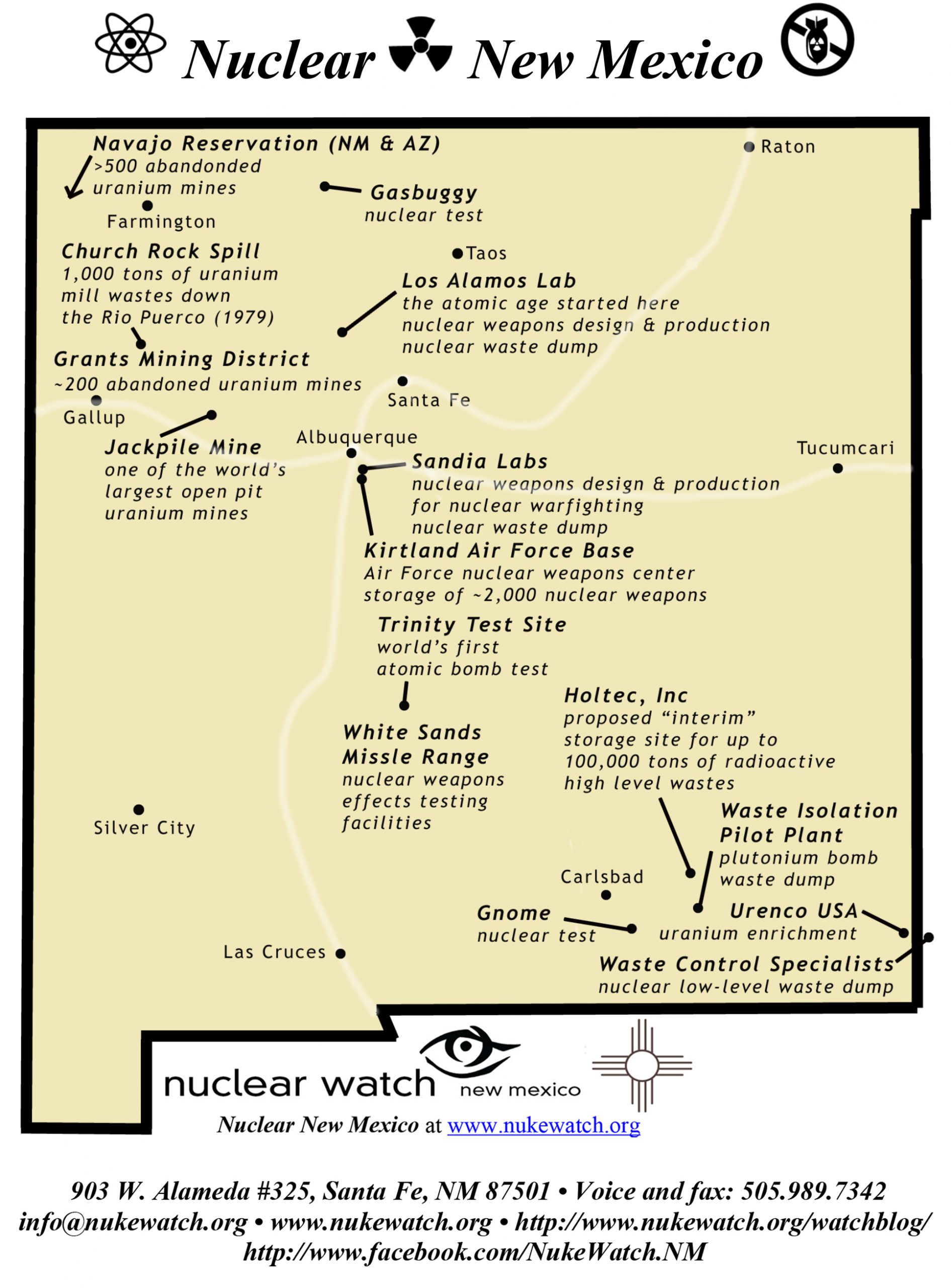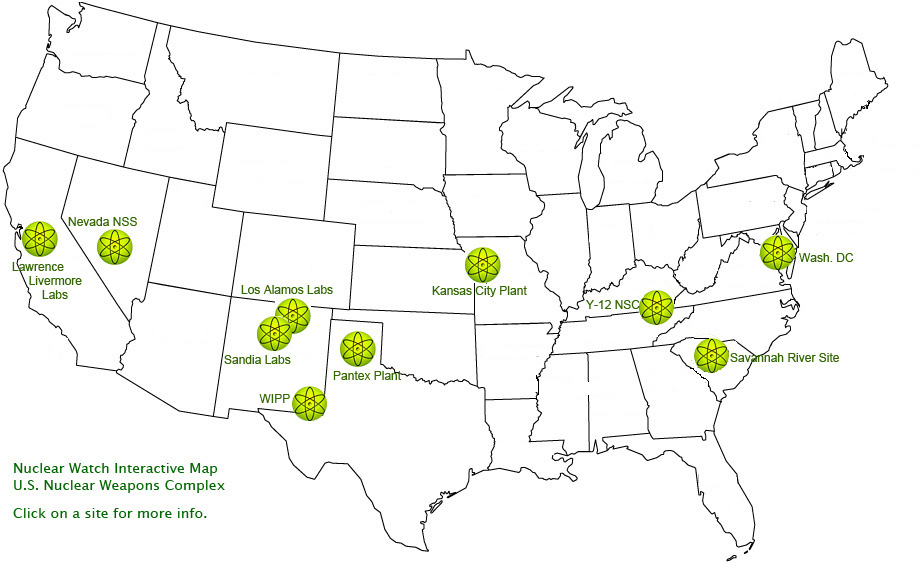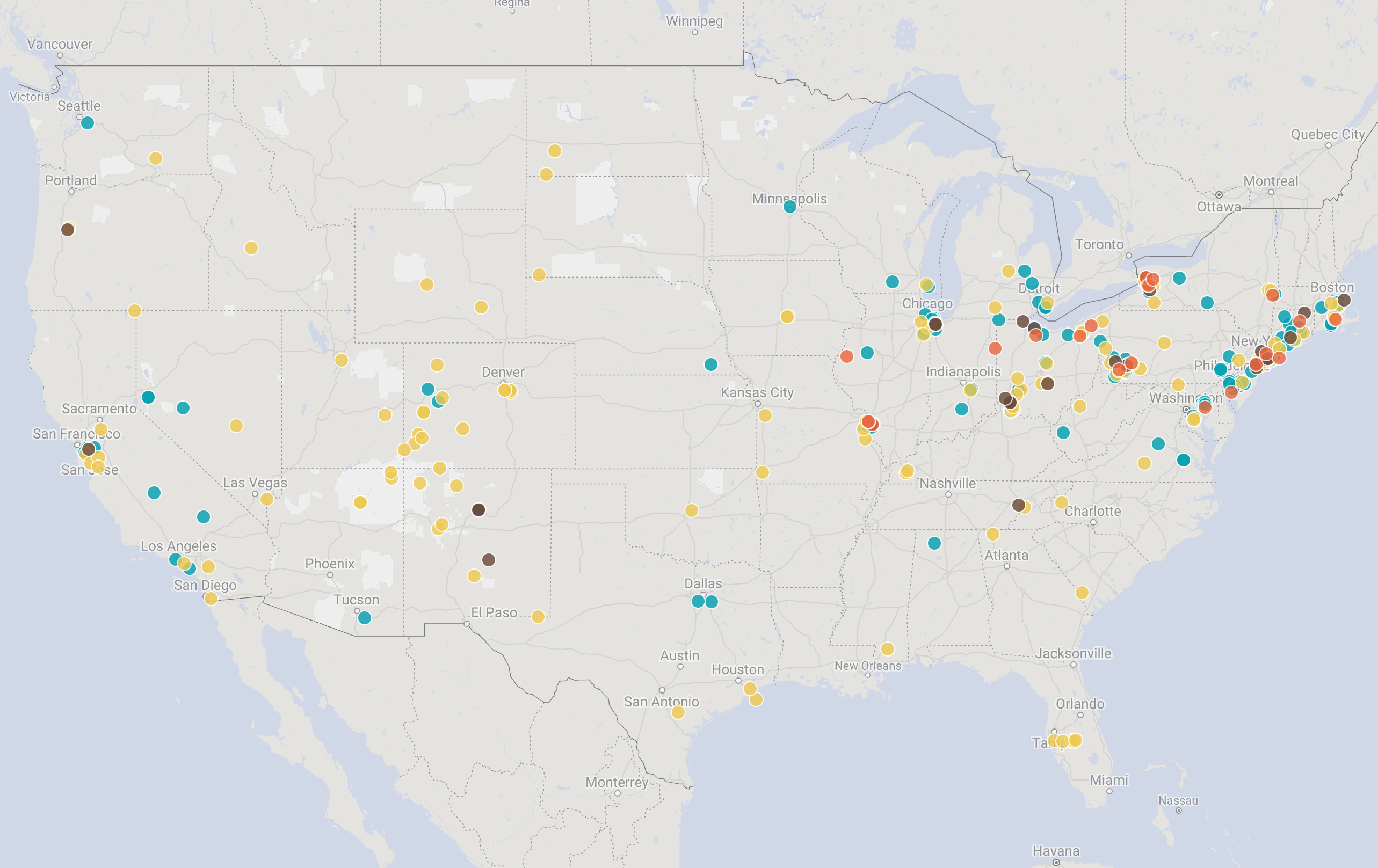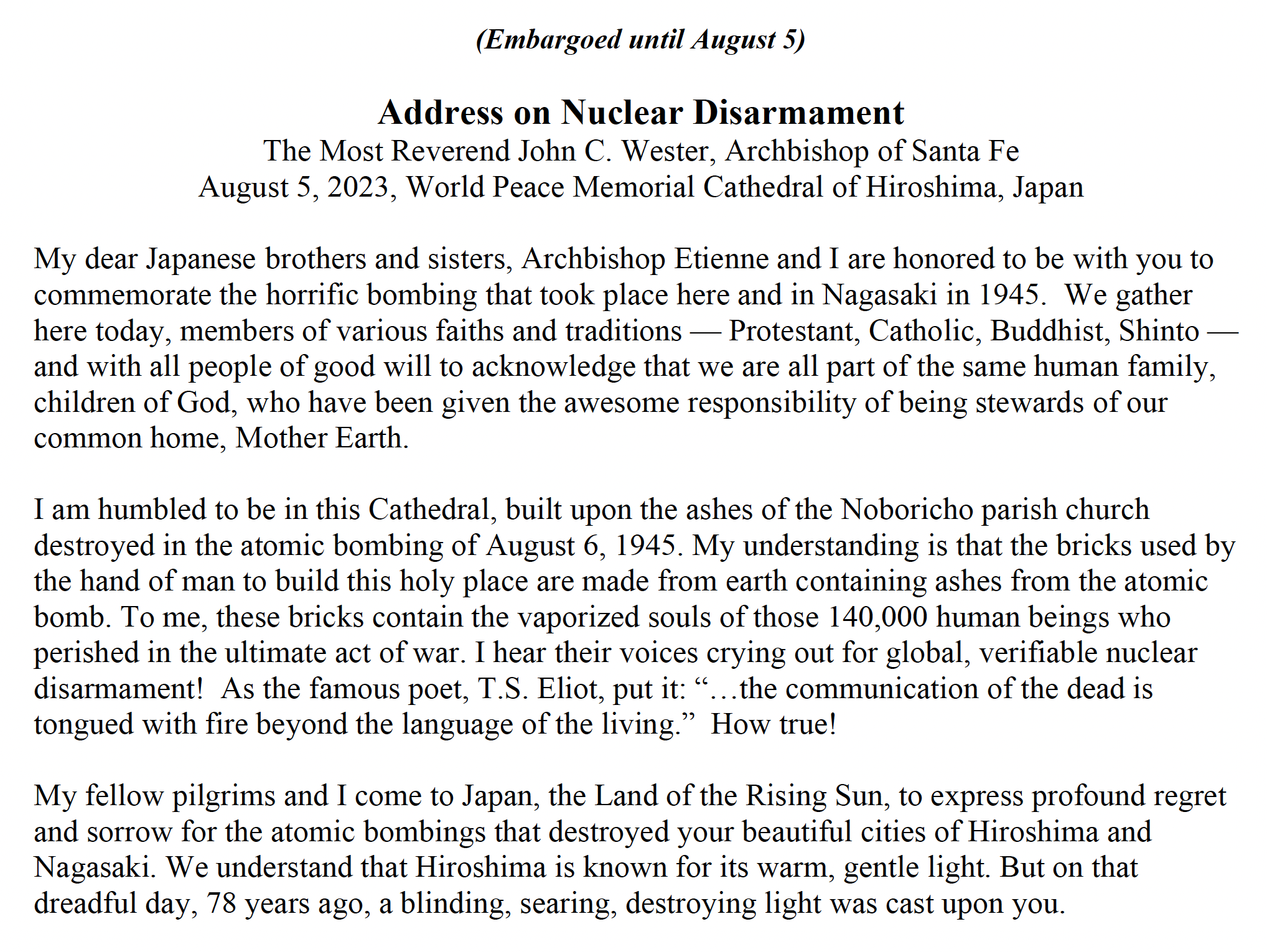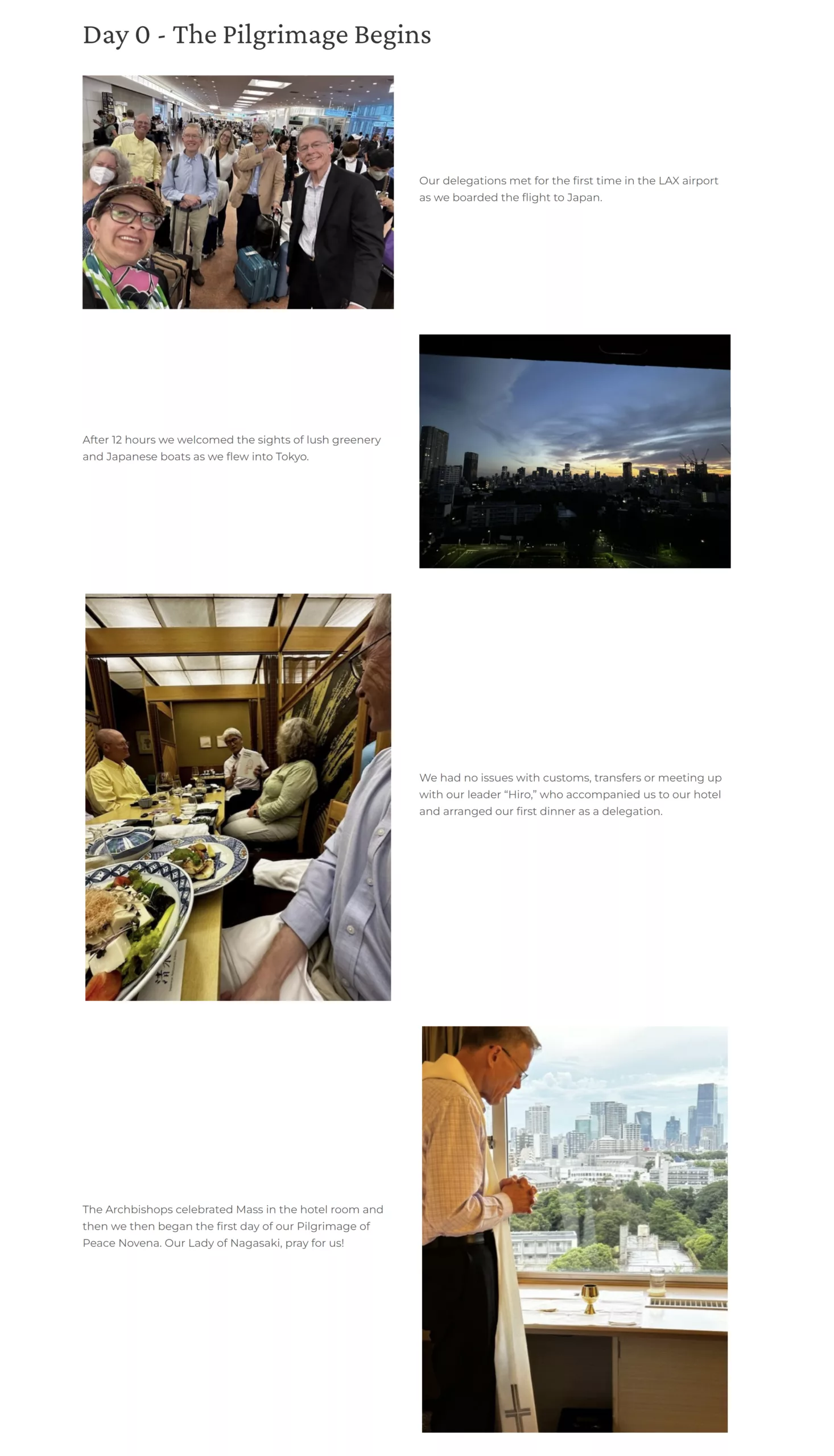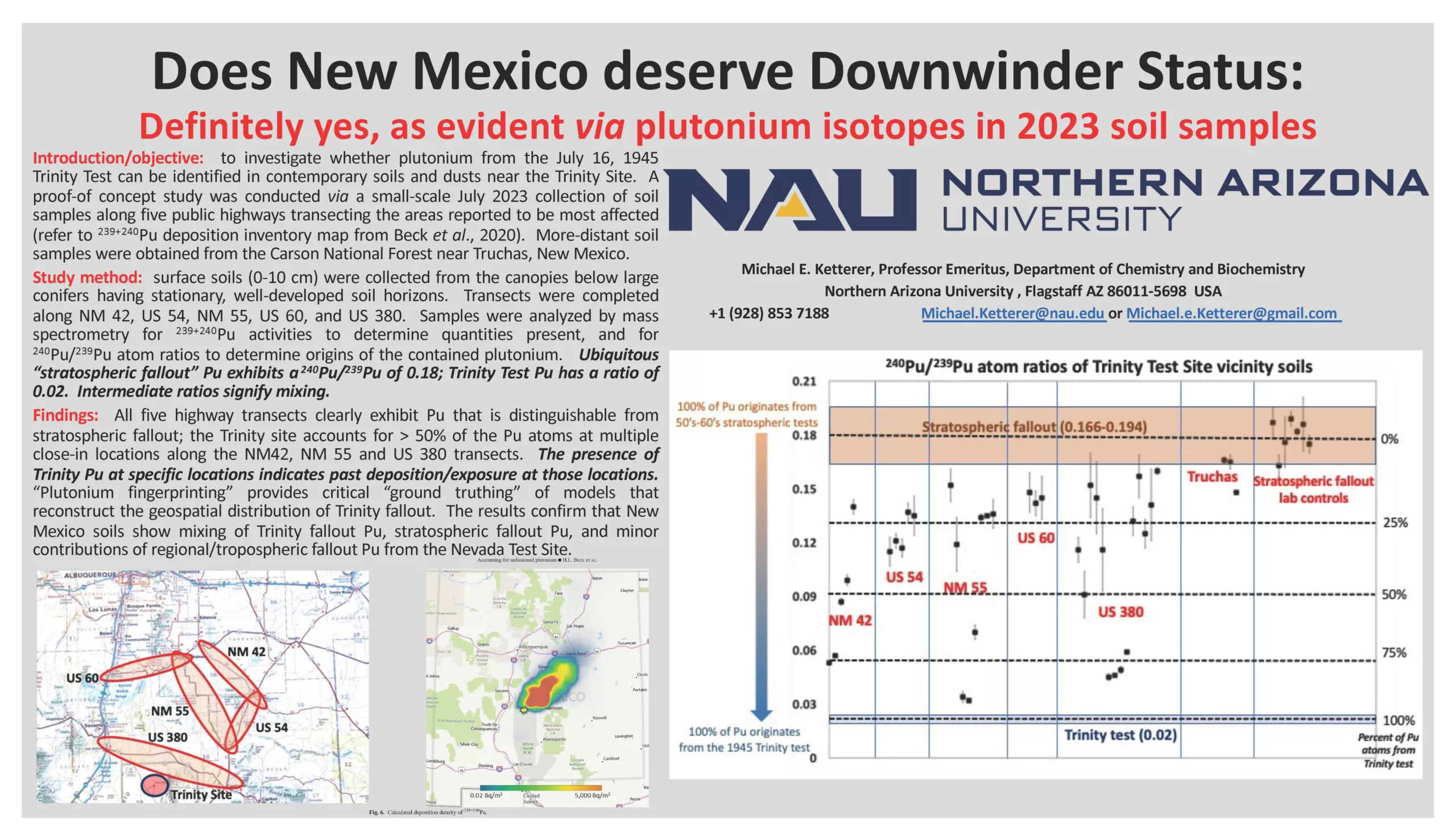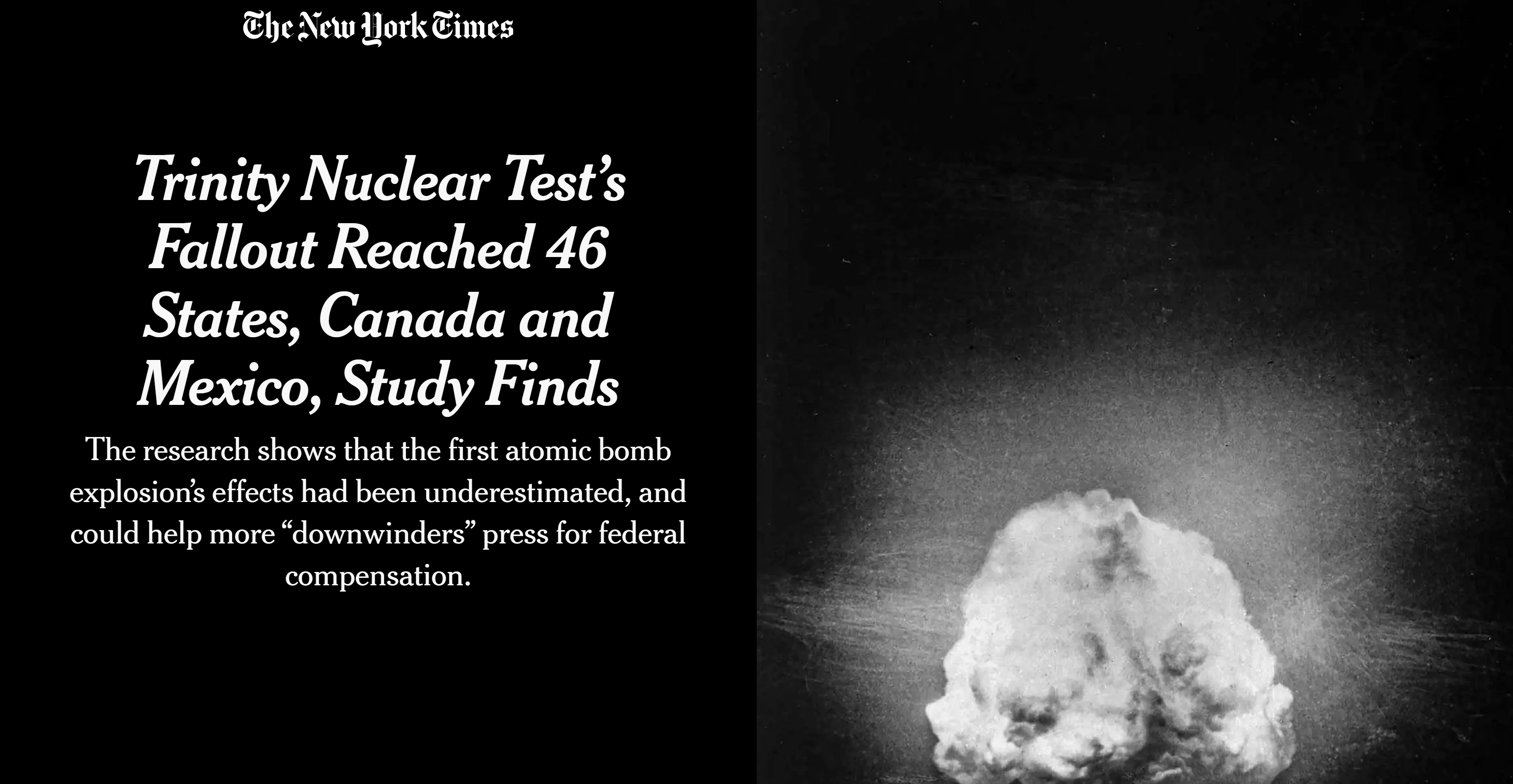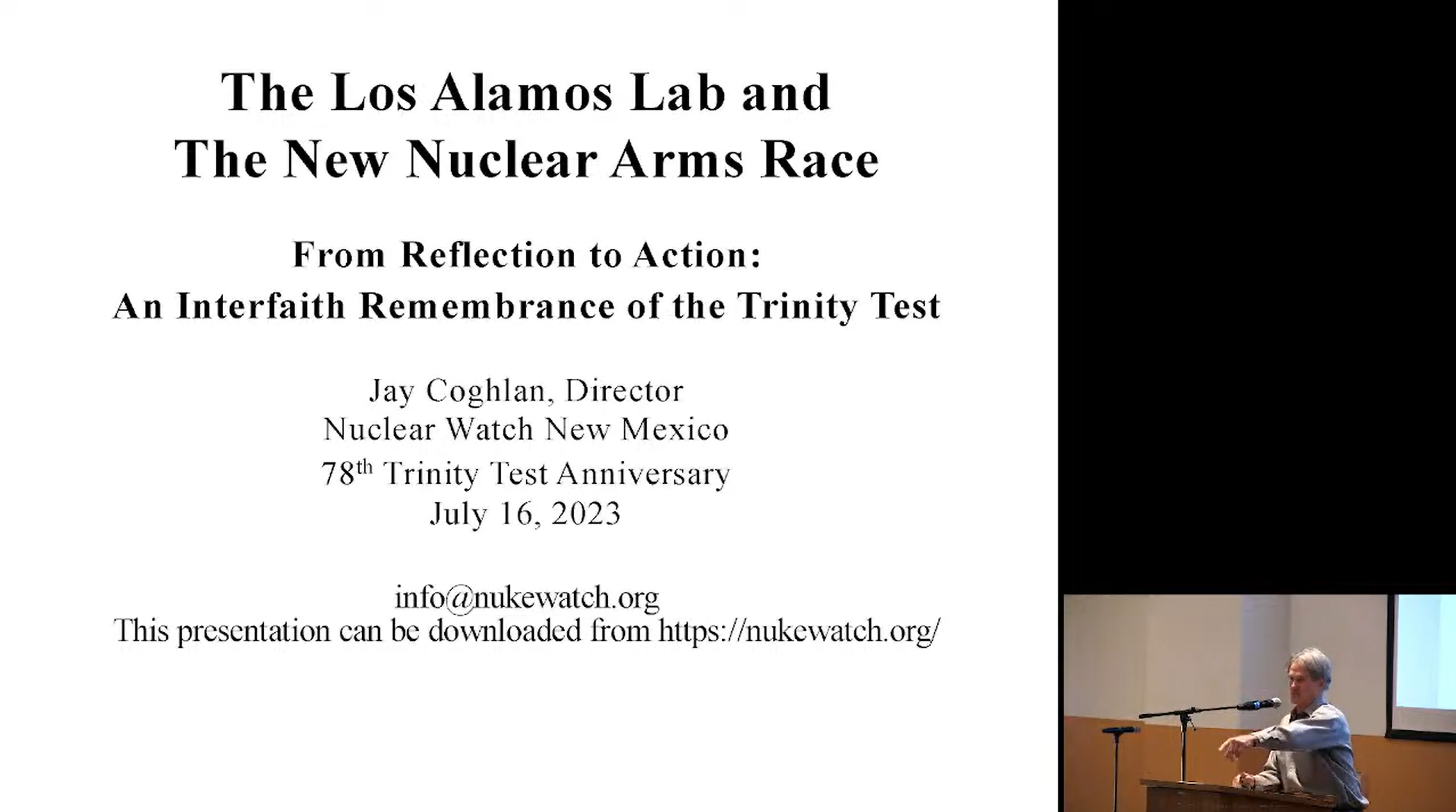QUOTE OF THE WEEK
Nothing Found
It seems we can’t find what you’re looking for. Perhaps searching can help.
LANL’s Central Mission: Los Alamos Lab officials have recently claimed that LANL has moved away from primarily nuclear weapons to “national security”, but what truly remains as the Labs central mission? Here’s the answer from one of its own documents:
LANL’s “Central Mission”- Presented at: RPI Nuclear Data 2011 Symposium for Criticality Safety and Reactor Applications (PDF) 4/27/11
Banner displaying “Nuclear Weapons Are Now Illegal” at the entrance in front of the Los Alamos National Lab to celebrate the Entry Into Force of the Nuclear Weapon Ban Treaty on January 22, 2021
Nothing Found
It seems we can’t find what you’re looking for. Perhaps searching can help.
Follow the Money!
Map of “Nuclear New Mexico”
Nuclear Watch Interactive Map – U.S. Nuclear Weapons Complex
In 1985, US President Ronald Reagan and and Russian President Mikhail Gorbachev declared that “a nuclear war cannot be won and must never be fought.”
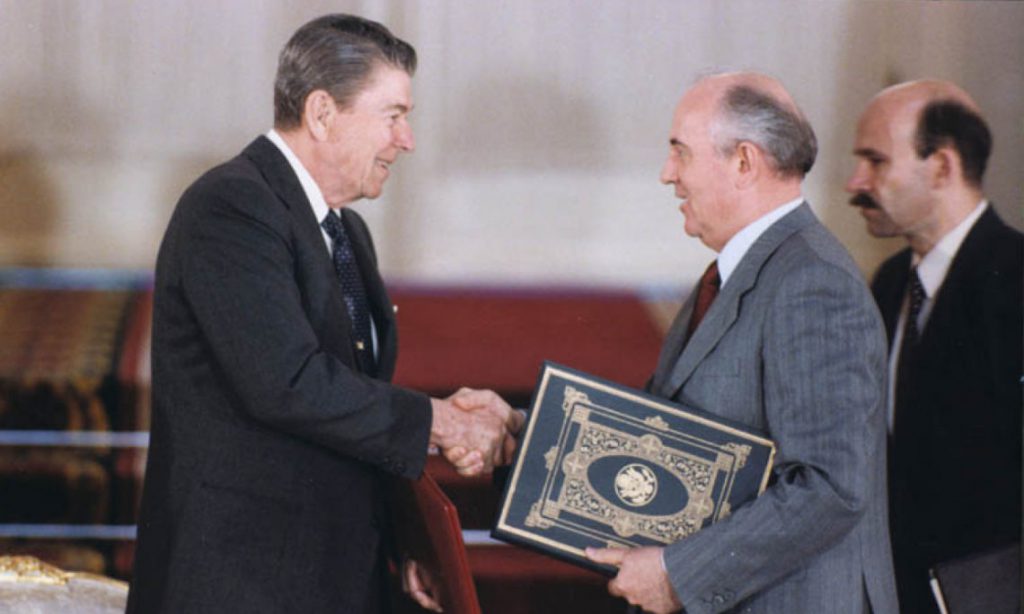
Waste Lands: America’s Forgotten Nuclear Legacy
The Wall St. Journal has compiled a searchable database of contaminated sites across the US. (view)
Related WSJ report: https://www.wsj.com
2022 BLOG POSTS
Nothing Found
It seems we can’t find what you’re looking for. Perhaps searching can help.
New & Updated
Novena for Nuclear Disarmament August 9, 2023 – Anniversary of Nagasaki Bombing
The Madonna of Nagasaki – Burnt 78 Years Ago by the Plutonium Bomb.

Breakthrough Study Bolsters RECA Claims for New Mexicans Exposed to Trinity Test Site Radiation
Plutonium Detections From Trinity Test Discovered 78 years After Test – Confirm RECA Must Be Expanded
Located in the Tularosa Basin in southern New Mexico, the Trinity Test Site marks the location of the first detonation of a nuclear weapon. Christopher Nolan’s “Oppenheimer” would have you believe this area is desolate, inhospitable and uninhabited. Contrary to this narrative and popular opinion, The area where the Trinity test occurred was not uninhabited. There were more than 13,000 New Mexicans living within a 50-mile radius. Many of those children, women and men were not warned before or after the test. The event marking the dawn of the nuclear age in July 1945 ushered in decades of health issues for residents living downwind due to exposure to radioactive fallout. The long-lasting impact of radiation exposure is a painful legacy that the New Mexican communities have had to bear.
New preliminary information strongly supports Radiation Exposure Compensation Act (RECA) status for New Mexicans downwind of the Trinity Test Site. In the past weeks, Michael E. Ketterer, (Professor Emeritus, Chemistry and Biochemistry, Northern Arizona University, Flagstaff, AZ) has completed a short “proof of principle” study that directly investigates where plutonium in soils originates by analyzing isotopic ratios, in a known portion of the Trinity Test plume.
Dr. Ketterer sampled soils along highways NM 42, US 54, NM 55, US 60, and US 380. The isotopes show that there is definitely plutonium from the Trinity Test in the northeast plume, and distinguishes it from global (stratospheric) background and New Mexico regional background from Nevada Test Site fallout. Soils along all five of these highways contain plutonium that reflects mixtures of Trinity Test debris and global/Nevada regional background fallout; in some cases, nearly 100% of the Pu originates from the Trinity Test.
Plutonium Detections From Trinity Test Discovered 78 years After Test – Confirm RECA Must Be Expanded
FOR IMMEDIATE RELEASE, July 31, 2023
Tina Cordova, Tularosa Basin Downwind Consortium – 505.897.6787 | Email
Dr. Michael E. Ketterer – 928.853.7188 | Email
Scott Kovac, Nuclear Watch New Mexico – 505.989.7342 | Email
Santa Fe, NM – New preliminary information strongly supports Radiation Exposure Compensation Act (RECA) status for New Mexicans downwind of the Trinity Test Site. In the past weeks, Michael E. Ketterer, (Professor Emeritus, Chemistry and Biochemistry, Northern Arizona University, Flagstaff, AZ) has completed a short “proof of principle” study that directly investigates where plutonium in soils originates by analyzing isotopic ratios, in a known portion of the Trinity Test plume.
Dr. Ketterer sampled soils along highways NM 42, US 54, NM 55, US 60, and US 380. The isotopes show that there is definitely plutonium from the Trinity Test in the northeast plume, and distinguishes it from global (stratospheric) background and New Mexico regional background from Nevada Test Site fallout. Soils along all five of these highways contain plutonium that reflects mixtures of Trinity Test debris and global/Nevada regional background fallout; in some cases, nearly 100% of the Pu originates from the Trinity Test.
While Dr. Ketterer has not encountered any activities (expressed as Bq/kg or pCi/g, Becquerels or picocuries respectively) of plutonium that cause alarm from the radio-toxicity standpoint, there’s very limited data.
Does New Mexico Deserve Downwinder Status: Definitely Yes, as Evident Via Plutonium Isotopes in 2023 Soil Samples
Michael E. Ketterer, Professor Emeritus, Department of Chemistry and Biochemistry
Northern Arizona University , Flagstaff AZ
Introduction/objective: to investigate whether plutonium from the July 16, 1945 Trinity Test can be identified in contemporary soils and dusts near the Trinity Site. A proof-of concept study was conducted via a small-scale July 2023 collection of soil samples along five public highways transecting the areas reported to be most affected (refer to 239+240Pu deposition inventory map from Beck et al., 2020). More-distant soil samples were obtained from the Carson National Forest near Truchas, New Mexico.
Nolan’s Oppenheimer treats New Mexico as a blank canvas
New Mexicans are integral to the history of atomic development and testing, but they’re nowhere to be seen on screen.
“We’ve been slept-walked into a new nuclear arms race, arguably far more dangerous than the first,” said John C. Wester, Archbishop of Santa Fe. “I grew up in the duck-and-cover generation. Perhaps some of you remember that. I felt chills many decades later when I read that Robert McNamara, defense secretary during the Cuban Missile Crisis, said that we survived that crisis only by luck. Luck is not a sustainable strategy for the survival of the human family.”
Jay Coghlan, of Nuclear Watch New Mexico, emphasized the danger from renewed plutonium pit production at Los Alamos, which he sees as both unnecessary for nuclear deterrence, and as risking development of new nuclear weapons.
BY KELSEY D. ATHERTON | July 28, 2023 sourcenm.com
In Christopher Nolan’s three-hour biopic “Oppenheimer,” released last week, the Manhattan Project comes to New Mexico largely because J. Robert Oppenheimer (Cillian Murphy) wishes it so. The film was shot in the Land of Enchantment with a hastily assembled Ghost Ranch set serving as the film’s freshly constructed Los Alamos. “Oppenheimer” features New Mexico as setting, backdrop, and refuge for the transplant scientists and military men who spent World War II developing the atom bomb. The film does not show the people already living in New Mexico, neither before the first shovel hits the dirt nor after Trinity’s radioactive fallout creates the first downwinders.
TIME – Inside the Los Alamos Lab Making Nuclear Bomb Parts Again
“It’s difficult to comprehend the level of contamination, the diversion of amounts of money into something that, in my view, will not improve national security,” says Jay Coghlan, executive director of Nuclear Watch New Mexico, a Santa Fe-based watchdog.
BY W.J. HENNIGAN/LOS ALAMOS, N.M. | July 24, 2023 time.com
In the Lab Oppenheimer Built, the U.S. Is Building Nuclear Bomb Cores Again
Something unusual is happening inside the plutonium facility at Los Alamos National Laboratory in New Mexico. PF-4, as it is known to top government officials, is the heart of America’s nuclear complex, a lab where scientists and engineers study and experiment on highly radioactive materials in tight secrecy…
New Mexico’s Latinos Confront Painful Past with ‘Oppenheimer,’ Revealing Another Side of the Story
“Tina Cordova is an activist seeking justice for the unknowing, unwilling, and uncompensated, innocent victims of the July 16, 1945, Trinity Test in south-central New Mexico.”
BY ALICIA CIVITA, Mitú | July 24, 2023 time.com
As the world eagerly awaits a sneak peek at Christopher Nolan’s film, “Oppenheimer,” a New Mexico community continues to be haunted by the legacy of the scientist the film portrays.
“Oppenheimer” explores the life of scientist J. Robert Oppenheimer and the secretive Manhattan Project for nuclear weapons research and development during World War II.
New York Times: Trinity Nuclear Test’s Fallout Reached 46 States, Canada and Mexico, Study Finds
“A new study, released on Thursday ahead of submission to a scientific journal for peer review, shows that the cloud and its fallout went farther than anyone in the Manhattan Project had imagined in 1945. Using state-of-the-art modeling software and recently uncovered historical weather data, the study’s authors say that radioactive fallout from the Trinity test reached 46 states, Canada and Mexico within 10 days of detonation.”
By Lesley M. Blume, THE NEW YORK TIMES | July 20, 2023 nytimes.com
In July 1945, as J. Robert Oppenheimer and the other researchers of the Manhattan Project prepared to test their brand-new atomic bomb in a New Mexico desert, they knew relatively little about how that mega-weapon would behave.
On July 16, when the plutonium-implosion device was set off atop a hundred-foot metal tower in a test code-named “Trinity,” the resultant blast was much stronger than anticipated. The irradiated mushroom cloud also went many times higher into the atmosphere than expected: some 50,000 to 70,000 feet. Where it would ultimately go was anyone’s guess.
Wester says New Mexico has to lead on nuclear weapon disarmament
“Counting on luck is not a winning strategy,” – Santa Fe Archbishop John Wester.
By Nathan Brown nbrown@sfnewmexican.com THE SANTA FE NEW MEXICAN | July 16, 2023 santafenewmexican.com
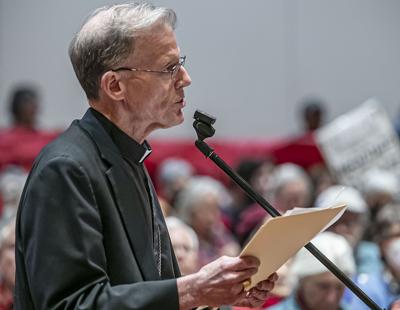
On July 16, 1945, the world was changed forever by a flash in the New Mexico desert.
The state’s link to that fateful day — from the builders of the first atomic bomb, to its 1945 detonation in a test at Trinity Site, to the victims of contamination decades later — gives New Mexico a special responsibility to lead the way to a peaceful future free of nuclear weapons, Archbishop of Santa Fe John Wester said Sunday afternoon…
…Seventy-eight years after the device was exploded in a test north of Alamogordo, its reverberations are still being felt. Wester has made nuclear disarmament one of his key causes. He and representatives of other faiths and anti-nuclear groups organized a prayer and remembrance ceremony Sunday afternoon at the Santa María de la Paz Community Hall on the anniversary of the Trinity test north of Alamogordo and a 1979 uranium mill spill near Church Rock.
“These are two examples of nuclear colonialism in rural New Mexican communities and what makes today such a politically and emotionally charged day,” said Myrriah Gómez, author of Nuclear Nuevo México, a book that examines the state’s nuclear history in the context of the Spanish and American colonialism that preceded it.
Gómez said the national laboratories that employ so many New Mexicans could be repurposed to discover cures for diseases such as cancer and Alzheimer’s.
Local Faith Groups To Host Interfaith Vigil Marking Anniversary Of Trinity Nuclear Test July 16 In Santa Fe
Submitted by Carol A. Clark, LOS ALAMOS DAILY POST | July 7, 2023 ladailypost.com
Nuclear Watch New Mexico News:
SANTA FE — To commemorate the anniversary of the first detonation of an atomic weapon in 1945 at the nearby Trinity Test Site, the complete elimination of nuclear weapons must be prioritized. “From Reflection to Action:
An Interfaith Remembrance of the Trinity Test” will be held at the Santa Maria de la Paz Community Hall in Santa Fe, featuring music, speakers, exhibitions, and moments of reflection and prayer. The free public event is 4-6 p.m. (doors open at 3:15 p.m.), Sunday, July 16, 2023. Pre-registration is encouraged, and the event will be live streamed.
Russian Nuclear Threat Returns With Kyiv’s Warnings Over Plant
Alarm is intensifying in Kyiv over the possibility that a Russian-occupied nuclear reactor in southern Ukraine could become a target of attack.
By Natalia Drozdiak and Sofia Gerace, BLOOMBERG NEWS | July 5, 2023 bloomberg.com
Ukrainian President Volodymyr Zelenskiy reinforced warnings that Russia may be planning to sabotage the Zaporizhzhia Nuclear Power Plant, which Moscow’s forces have occupied since the start of the war. In response, the Kremlin accused the government in Kyiv of planning its own provocation. Concern has run high since last month’s destruction of the Kakhovka dam triggered catastrophic flooding and drained a reservoir used for the plant’s cooling system. The UN’s atomic watchdog agency, which has said it’s seen no evidence of explosives, is seeking fresh access to rooftops of reactors and other parts of the complex, IAEA chief Rafael Mariano Grossi said.
ACTION ALERTS
Nothing Found
It seems we can’t find what you’re looking for. Perhaps searching can help.
Nothing Found
It seems we can’t find what you’re looking for. Perhaps searching can help.
Interfaith Panel Discussion on Nuclear Disarmament - August 9
Nothing Found
It seems we can’t find what you’re looking for. Perhaps searching can help.
New Nuclear Media
Nothing Found
It seems we can’t find what you’re looking for. Perhaps searching can help.

